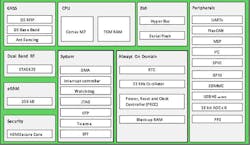Single-Chip, Triple-Band GNSS Receiver Boosts Automotive Positioning Accuracy
Joining its Teseo V family, STMicroelectronics claims the STA8135GA is the first automotive-qualified Global Navigation Satellite System (GNSS) receiver to integrate a triple-band positioning measurement engine on-chip, delivering the position data needed by advanced driving systems. What’s more, the multi-constellation positioning receiver IC handles standard multi-band position-velocity-time (PVT) and dead reckoning.
By way of review, the velocity-time graph is derived from the position-time graph. The difference is that the velocity-time graph reveals the speed of an object—and whether it’s slowing down or accelerating—while the position-time graph describes the motion of an object over a period of time.
Upping the Accuracy Ante
Triple-band has historically been used in professional applications such as surveying, mapping, and precision agriculture that demand millimeter accuracy with minimal reliance on correction data. Only available in chipsets or modules up to now, which are typically larger and more expensive than this single-chip solution, triple-band enables the receiver to efficiently acquire and track the largest number of satellites in multiple constellations simultaneously. This capability delivers superior performance in difficult conditions such as in urban canyons and under tree cover.
“The high precision and single-chip integration delivered by the STA8135GA satellite receiver enables the creation of reliable and affordable navigation systems that enable vehicles to be safer and more context aware,” said Luca Celant, General Manager, ADAS, ASIC and Audio Division, Automotive and Discrete Group, STMicroelectronics.
What’s Included?
STMicroelectronics’ 5th-generation positioning receiver has 80 tracking channels and four fast-acquisition channels compatible with GPS, Galileo, GLONASS, BeiDou, NAVIC (formerly IRNSS), and QZSS in L1, L2, L5, and E6 frequency bands. It simultaneously receives three frequencies (L1/L2/L5 or L1/L5/E6) in a single package without the need of any external RF front end. The STA8135GA multichip module (MCM) combines both the STA8100GA and STA5635A.
The Teseo V family embeds an Arm Cortex-M7 microprocessor with an RF front end able to support different bands and UART communication interfaces. Performance and configuration can be analyzed using the Teseo Suite PC Tool.
Bringing this capability to the automotive market in a compact package, the STA8135GA helps driver-assistance systems make accurate decisions about the road ahead. The multi-constellation receiver delivers raw information for the host system to run any precise-positioning algorithm, such as precise point positioning/real-time kinematic (PPP/RTK). The STA8135GA also enhances the performance of in-dash navigation systems, telematics equipment, smart antennas, and V2X communication systems.
Furthermore, the STA8135GA integrates separate low-dropout (LDO) voltage regulators on-chip to supply the IC’s analog circuitry, digital core, and I/O transceivers thereby simplifying selection of the external power supply.
Qualifications and Evaluation
The STA8135GA is compliant with ST Automotive Grade qualification that includes, in addition to AEC-Q100 requirements, a set of production flow methodologies targeting zero defect per million, according to the company. The STA8135GA is well-suited for in-dash navigation, smart antenna, car-to-car, V2X, OEM telematics, marine, drone, and many other applications requiring precise positioning.
Helping engineers is ST’s EVB-T5MCM board, a complete standalone evaluation platform for Teseo-V STA8135GA GNSS triple-band and multi-constellation receiver IC solutions. Boot and Reset buttons allow for an easy programming procedure while the 4-pin connector enables access to ODO/CAN signals to simplify car connections.
The STA8135GA is manufactured using CMOS technology and housed in a 7- × 11- × 1.2-mm BGA package. Samples are available now and full-qualification AEC-Q100 and start of production are scheduled for Q1 2022.

